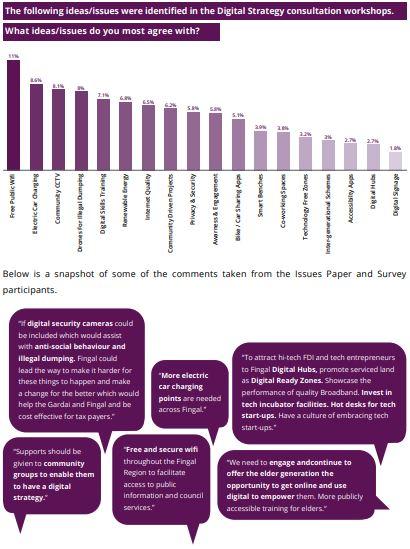Straitéis Dhigiteach Fhine Gall 2020 - 2023

Teachtaireacht ón bPríomhfheidhmeannach
Tá Comhairle Contae Fhine Gall dírithe air go bhfeabhsófar an geilleagar digiteach agus go dtacófar
le pobail a bheith in ann leas a bhaint as sochaí atá cumasaithe go digiteach.
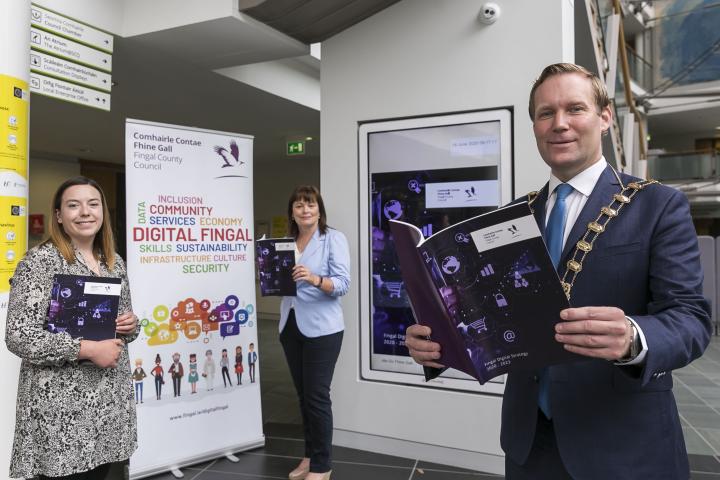
Teachtaireacht ón Méara
Tá sé mar aidhm ag Straitéis Dhigiteach Chomhairle Contae Fhine Gall saoránaigh, gnóthais agus cuairteoirí a spreagadh agus tacú leo chun iomlán an bhuntáiste atá i gceist le sochaí atá éascaithe ar bhonn digiteach a bhaint amach.

Achoimre Fheidhmeach
Rinne Comhairle Contae Fhine Gall an straitéis dhigiteach seo a fhorbairt chun pobail agus gnóthais a spreagadh agus a thacú ionas gur féidir leo na buntáistí iomlána a bhaineann le sochaí atá cumasaithe go digiteach a bhaint amach

An Fhís
Is í an fhís atá againn ná go ndéanfar ár ndícheall Fine Gall a fhorbairt mar cheantar ionas gurb é an áit is fearr in Éirinn chun cónaí nó obair ann, chun cuairt a thabhairt air agus chun gnó a dhéanamh ann. Tá sé mar aidhm ag an straitéis seo pobail agus gnóthais a spreagadh agus a thacú ionas gur féidir leo na buntáistí iomlána a bhaineann le sochaí atá cumasaithe go digiteach a bhaint amach.

Na Prionsabail
Beidh seacht bprionsabal mar bhonn agus mar thaca ag forbairt na straitéise digití d’Fhine Gall agus gníomhaíochtaí gaolmhara, pleananna agus tionscnaimh bheartais.

An Bonneagar Digiteach
Is í an fhís atá againn don chrann taca seo ná bonneagar digiteach den scoth a fhorbairt ar fud Fhine Gall, lena ndéanfar cinnte de go bhfuil an bonneagar digiteach atá oiriúnach don fheidhm curtha ar fáil ar fud Fhine Gall, sna ceantair tuaithe agus uirbeacha araon.
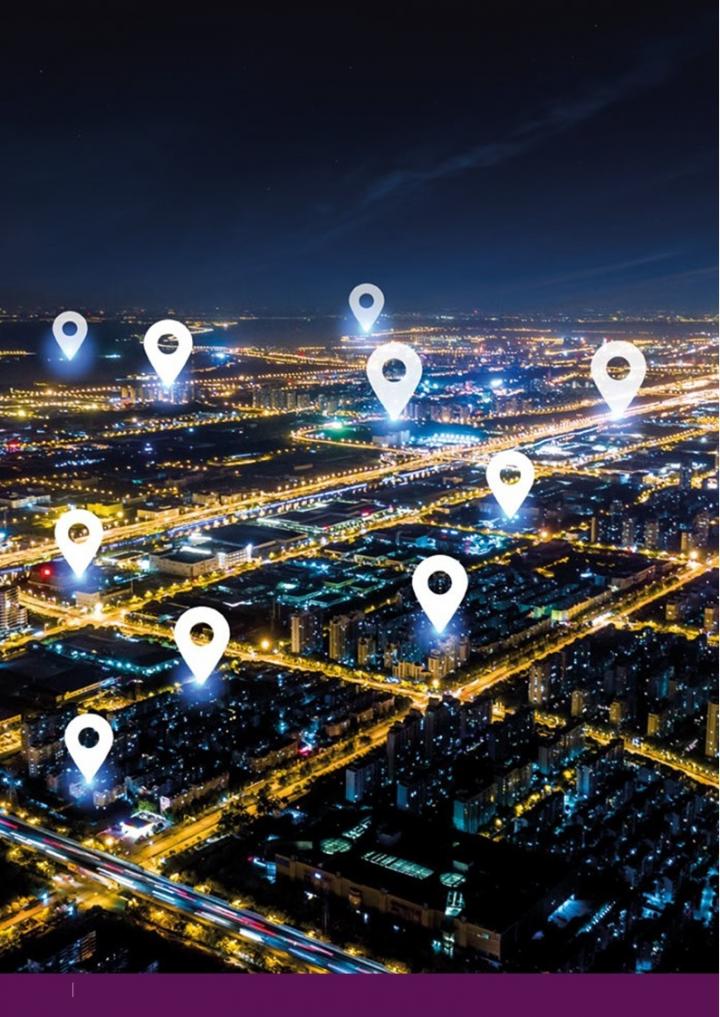
An Pobal Digiteach
Is í an fhís atá againn don chrann taca seo ná saoránaigh agus pobail a chumhachtú a bheith in ann páirt a ghlacadh i bhforbairt a bpobal agus iad a chur ar a gcumas na pobail sin a chur chun cinn agus tacú leo rochtain a fháil ar scileanna digiteacha, agus ar sheirbhísí digiteacha go mbeifear in ann deiseanna a chur ar fáil do chuile dhuine dá bharr.

An Gnó Digiteach
Is í an fhís a ghabhann leis an gcrann taca seo ná Fine Gall a fhorbairt ionas gurb é an áit is fearr chun gnólacht a thionscain agus a fhás araon.

An Rialtas Digiteach
Is í an fhís a ghabhann leis an gcrann taca seo ná príomhsheirbhísí poiblí a athrú ó bhonn, agus béim curtha san athrú sin ar éifeachtúlachtaí agus an inrochtaineacht do chách a chur ar aghaidh chomh maith le seirbhísí digiteacha poiblí a dhearadh atá uilechuimsitheach ar bhonn uathoibríoch.

The internet and digital technologies are transforming the way people live, work and communicate today. We are in the era now known as the digital age or information age. Information is readily available and accessible through digital technologies and people born into this era are described as digital natives – someone who has used the internet and mobile phones since they were a child. Technologies are constantly evolving and developing. We can see this especially in recent years with advances in the internet of things (IOT), artificial intelligence (AI) and machine learning – for example, electric cars, driverless vehicles, contactless payments, smart home appliances. As a result, consumer preferences have changed – people want to access more services online and at a time and place convenient for them.
We are using online services for shopping, banking, paying bills, information and entertainment because they tend to be more convenient and cheaper to use. Research carried out by Ipsos MORI on behalf of Deloitte found that three million people in Ireland, equivalent to 90% of the population, now have access to a smartphone - higher than the European average. The survey revealed that mobile phone usage among older people grew by 6% to 54% from 2016 to 2017, with eight in every ten of those carrying a smartphone. It also found that 83% of Irish people have access to at least one IoT device against a European average of 73%.
As a result of the technological advances in society Local Government need to evolve and adapt to ensure our citizens, business and communities remain well served.
The importance of the internet to our economy is becoming more and more evident each year. In 2016, Indecon Economic Consultants were commissioned by The Department of Communications, Climate Action and Environment to carry out an Assessment of the macro-economic impact of the internet and digital on the Irish economy.
This report found that:
•
The digital economy represents 6% (€12.3bn) of Ireland’s GDP.
•
It is growing fast, at approximately 40% since 2012.
•
The digital economy is expected to expand to about €21.4 billion or 7.9% of GDP by 2020.
•
Currently almost 116,000 direct and indirect jobs are supported, of which 68,000 are directly linked to digital.
•
The largest single contributor to the internet part of the economy is online consumer spending.
•
Irish consumers spend around €850,000 per hour online, 24 hours a day, which represents more than a 20% increase since 2012.
•
Irish consumers expect this to grow by 25% in the next 3 – 5 years.
•
88% of Irish consumers research products online before buying, compared to 79% across the EU.
•
Approximately one in seven Irish people (13.5% of the adult population) make a supplementary income on the internet.
In recent years cities around the world are now moving towards the concept of a ‘Smart City’, using technology to improve the way citizens interact with the city. Smart Cities and regions use data and technology to create efficiencies, improve sustainability, create economic development, and enhance quality of life factors for people. Smart Cities is one of the fastest growth markets globally, with Allied Market Research reporting that the global Smart Cities market was valued at $517,629 million in 2017 and is projected to reach $2,402,123 million by 2025, registering a compound annual growth rate of 21.28% from 2018 to 2025.
Smart Dublin, an initiative of the four Dublin Local Authorities, aims to position Dublin as a world leader in the development of new urban solutions, using open data, and with the city region as a test bed. As a founding member of the Smart Dublin initiative in 2016, Fingal County Council has actively sought to capitalise on the abundance of opportunities presented by the global Smart Cities movement for both internal digital transformation and to stimulate economic vibrancy in the region.
Fingal has a population of 296,214, making it the third largest, fastest growing, and youngest population of any county in Ireland. This represents a growth of close to 80% in comparison with 30% nationally since 1996. Since the 2011 census the population of Fingal has increased by 8% and by 2021 the population of this vibrant and diverse county is expected to be over 330,000. The population is ethnically and culturally diverse; 23% of the population were born outside of Ireland. Balbriggan, located in the north of the county, is Ireland’s youngest, fastest growing and most diverse town in Ireland and over half of the population of Mulhuddart in Dublin 15 are under the age of 25.
Fingal’s rapidly growing, diverse, young population presents a myriad of opportunities and challenges for the county. By developing a digital strategy for Fingal, we hope to deliver better services to our growing population and support communities, businesses and citizens to leverage the full potential of broadband and digital technologies.
Fingal has major economic assets, including Dublin Airport, proximity to Dublin City and the Dublin Port Tunnel, road and rail infrastructure and a prime location on the Dublin-Belfast Economic corridor. Dublin Airport provides a significant economic hub for the county. Fingal has close links with Third Level Higher Education Institutes. Technological University Dublin
- Ireland’s first Technological University - has a campus based in Blanchardstown, Dublin 15. Fingal is also home to the Dublin Enterprise Zone (DEZ). The DEZ comprises of 1,571 hectares of land zoned for office, R&D, High Technology Manufacturing, Industrial and General Enterprise and Employment, and is located just north of the N3 and south of the N2. The DEZ is one of the largest enterprise zones in Ireland and adds €14.4 billion to the national economic output while supporting 34,600 jobs. Fingal County Council has built a strong and dynamic ICT cluster in the Blanchardstown area with multi-national companies such as Synopsys, IBM, Amazon, PayPal and Symantec.
Fingal’s Digital Strategy will leverage the supports of the world-leading science, technology, innovation and research ecosystem to support strategy goals and objectives and grow Digital Fingal.
Fingal is made up of a mix of rural, urban and suburban regions. The OECD has acknowledged the importance of broadband and digital infrastructure to both rural and urban communities. The term “digital divide” is commonly used to refer to different levels of access and use of information and communication technologies (ICTs) and, more specifically, to the gaps in access and use of internet based digital services. Broadband access provides the physical means for using these services, with availability gaps continuing to be a challenge in many rural and remote locations. In recent years, the increased role broadband connectivity plays in economic and social interaction has made this aspect of the digital divide a key matter for public policy.31 The National Broadband Plan (NBP) (2015) aims to deliver reliable high-speed broadband throughout Ireland through a combination of State and commercial investment. Fingal County Council is committed to facilitating the rollout of the NBP and recognises the vital role broadband will play in Fingal’s urban and rural economic and social development.
To help our local economy and communities to take full advantage of the opportunities that digital presents, local digital strategies are of vital importance.

The European Commission has been a driver of digital for many years. In 2015 the Commission developed Europe’s 2020 Strategy which set out objectives for the growth of the European Union (EU) by 2020. This strategy was built around seven pillars, the Digital Agenda formed one of these key growth pillars. The Digital Agenda’s main objective was to develop a digital single market in order to generate smart, sustainable and inclusive growth in Europe.
The core focus of the European Commission’s Digital Single Market Strategy is for European citizens to benefit from developments in digital connectivity, digital skills, digital public services, and investment in research, development and innovation in ICT. The EU Commission is encouraging and supporting member states to develop their digital infrastructure and services through a series of funding opportunities. The WiFi4EU initiative was launched in May 2018 with a fund of €120 million and aims to promote access to wireless connectivity and usage in public places. The EU Commission has also proposed to invest a further €9.2 billion in the first ever Digital Europe programme. Fingal County Council aims to optimise its digital infrastructure and services through EU Commission funding supports and other support and development initiatives.
As part of the Digital Single Market strategy, the European Commission annually publishes the European Digital Progress Report (EDPR), which monitors progress in digital policies in the Member States.
Digital Dimension Description
|
1 Connectivity |
Fixed broadband, mobile broadband, broadband speed and prices |
|
2 Human Capital |
Internet use, basic and advanced digital skills |
|
3 Use of Internet |
Citizens’ use of content, communication and online transactions |
|
4 Integration of Digital Technology |
Business digitisation and eCommerce |
|
5 Digital Public Services |
eGovernment |
The 2018 report showed that Denmark, Sweden, Finland, and the Netherlands have the most advanced digital economies in the EU followed by Luxembourg, Ireland, the UK, Belgium and Estonia on the Digital Economy and Society Index (DESI).
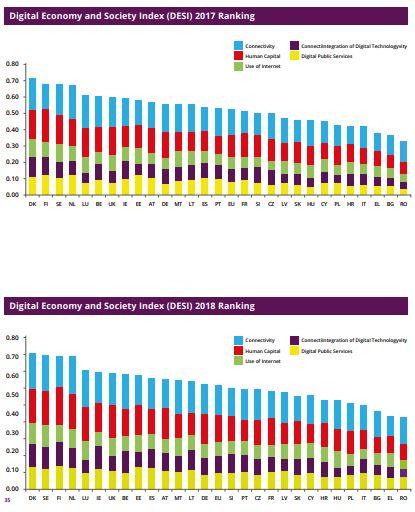
In 2017, Ireland ranked eight as most digitised nation among its EU Member States and in 2018 Ireland improved its overall performance and was ranked sixth overall in the Digital Economy and Society Index report.
In recent years, the Irish Government has prioritised the delivery and implementation of the EU digital agenda and Digital Single Market through development and implementation of the National Broadband Plan and by progressing national and local digital strategies.
The Department of Communications, Climate Action and Environment (DCCAE) has been a driver of digital for some time. In 2013, DCCAE published the National Digital Strategy36 for Ireland. It focused on three target areas:
•
Enterprise – a key aim was to get 10,000 businesses online for the first time and 2,000 trading online
•
Citizens – a key aim was “to halve the number of “non-liners” (people who have not yet engaged with the internet) by 2016”
•
Education – among many initiatives the “completion of the rollout of 100mbs to all post primary schools” was a key target
Under the Action Plan for Jobs 2018 a framework for a high level National Digital Strategy is currently in development. The purpose of this Strategy is to provide a whole of government approach to digital and it will enable Ireland to maximise the economic and societal benefits that arise from on-going digital developments. A Digital Strategy Interdepartmental Group has been established to support the National Digital Strategy.
|
Local Level |
At a local and regional level digital already plays an important role in existing strategies. The Fingal County Development Plan 2017-2023, Section 6.5 Information and Communications Technology outlines Fingal County Council’s policy to grow the ICT presence in the county to maximise growth opportunities in the sector.
Fingal Libraries Development Plan 2018-2023 identifies the need for access to information technology, digital services and skills through its core objectives. Objective 5 focuses on technology. It states that states that Fingal Libraries will ‘provide training opportunities to bridge the digital divide internally and externally. Fingal Libraries are committed to providing an innovative and technology-rich service that will meet the present and future needs of our communities’. Access to high-speed broadband in all Fingal Libraries is an action within the Library Development Plan.
Figal Age Friendly Strategy 2018-2023 identifies the need to support senior citizens to bridge the digital divide. The increasing digitisation of society is impacting on the lives of senior citizens with the closure of post offices, banks and a proliferation of services being carried out online. In this context, there is a need to ensure our older citizens are facilitated and supported in a manner which bridges the digital divide while still respecting their choices and needs. The Age Friendly Strategy outlines a core goal to help bridge that divide.
The Fingal Skills Strategy has identified critical skills shortages for the Professional Services sector. The analysis indicates a significant gap of up to 919 Professional, Associate Professional and Technical Occupations per annum. In order to meet the demand for highly skilled technical workforce the report recommends that education providers and Fingal County Council work to improve promote digital skills services and courses.
Fingal Local Economic and Community Plan (LECP) 2016–2020 outlines the importance of digital for the growth of communities. The plan prioritises digital in High-Level Goal 4: To maximise Training and job creation Working opportunities by activating the potential within local communities. Action 33: Maximise the potential of e-learning, up-skill communities in ICT, and facilitate access to technologies so as to enable the use of eLearning and access to information.

With regard to telecoms infrastructure, Fingal is better served than its more rural neighbouring counties, but it still experiences a rural-urban divide for high speed broadband services which has left rural communities disadvantaged for their living and working requirements. Latest figures available from the DCCAE (Q2-2019 - Table 1) show just under 9% of premises have no access to reliable high-speed broadband services.
Engagement with local citizens and business have revealed that pockets or blackspots of poor connectivity exist within the blue area of the National Broadband Plan map. A consultation on conclusion of the National Broadband Plan mapping exercise for the 'Intervention Area' has recently been undertaken (Q3-2019) with relevant agencies and the telecoms industry to update the National Broadband Plan intervention area.
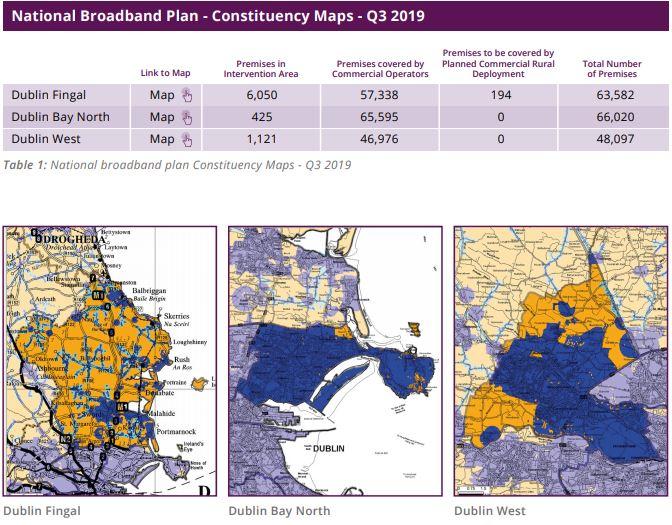
Digital Readiness Assessment
In January 2018, The Department of Rural and Community Development contracted Indecon Economic Consultants to undertake a Digital Readiness Assessment (DRA) of each local authority. The DRAs provide an overview of each county’s digital maturity, highlighting strengths and weaknesses and can be used as a guide to measure progress.
The DRAs look at local authority public services and infrastructure, citizens, businesses, as well as the activities of the Council itself. The report sets out a seven-pillar approach to digital maturity.
The seven pillars identified are:

The county’s performance was compared with a peer group of counties with a similar urban rural population division and with the Country as a whole.
Fingal County Council performed higher than the national average on each of the seven pillars and is performing on par with its peer group.
The DRA classed Fingal County as ‘Highly Developed’ in terms of digital innovation and entrepreneurship and ranks the county as ‘Transformational’ in terms of digital infrastructure. The report also ranked Fingal County as ‘Developed/Highly Developed’ with regard to the provision of digital services.
Fingal’s Digital Strategy will build on the success to date under these pillars to ensure maximum digital optimisation and transformation for citizens, businesses and government.
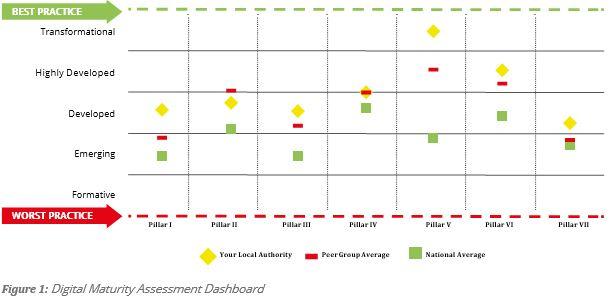

In order to create an inclusive Digital Strategy and implementation plan for Fingal, a comprehensive consultation and engagement process was undertaken. This process involved a number of measures, including analysis of relevant policy and documents, formation of an oversight group, development of a public issues paper, design thinking workshops with community and business stakeholders and the development of a consultation survey.
The formation of the Digital Fingal Oversight Group was a fundamental first step in developing a digital strategy for Fingal. The oversight group was set up to oversee the development of a digital strategy and implementation plan. This group is comprised of senior representatives from Fingal County Council. These representatives are crucial to the success of the Strategy and implementation plan and represent the following council departments – Economic Development, Community, Libraries, Finance, Planning, Operations, Environment, Architects, Corporate Affairs and Governance, Data Protection and Communications. Participants are listed in Appendix A.
The role of the oversight group was to firstly discuss the potential a digital strategy could have on their departments, highlight existing digital initiatives in their respective departments and discover potential digital projects that might be included in the strategy. Through this engagement process the group identified the need for further engagement with both internal and external digital champions to drive the digital agenda. This engagement process led to a robust consultation with both internal and external digital champions. The figure below shows the breakdown of the stakeholder engagement process.
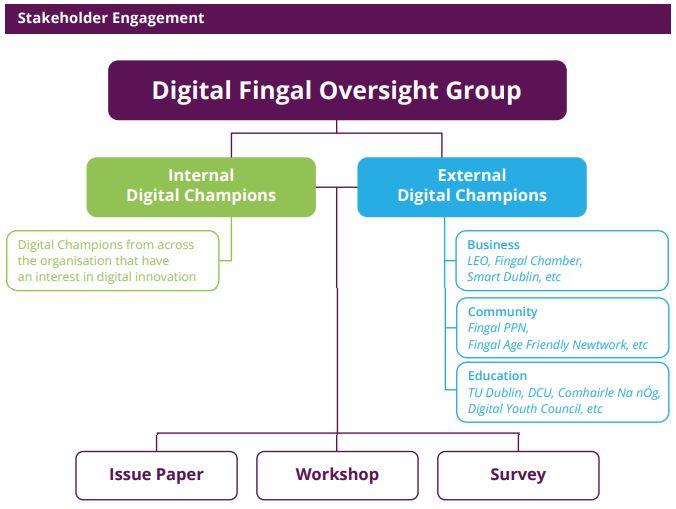
The other core focus of the oversight group is to assist in the development and implementation of a Digital Strategy for Fingal.
The Digital Strategy Consultation involved three main methods of engagement – the publication of an Issues Paper and online consultation; various consultation workshops with strategic stakeholder groups; the publication of an online survey to obtain input from a wider audience.
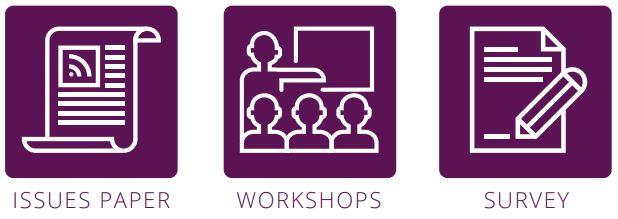
The core objectives of the Digital Strategy Consultation were:
•
To inform the development of Fingal County Council Digital Strategy with insight from relevant stakeholders
•
To enable and encourage engagement and meaningful dialogue between key stakeholders and with the Fingal County Council Digital Fingal team
The Digital Strategy Issues Paper was published on the Council’s consultation portal and was shared widely through the Council’s communication channels. The Issues Paper consultation was open from 4 June until 28 July 2019. The purpose of the Issues Paper consultation was to ask members of the public for their comments, submissions or suggestions relating to the Digital Strategy. The paper presented an overview of the strategy framework and posed questions to encourage discussion and debate on what the public wanted to see in their digital strategy.
The snippet below is an extract from the Issues Paper outlining questions to consider when commenting on the Digital Economy Pillar.
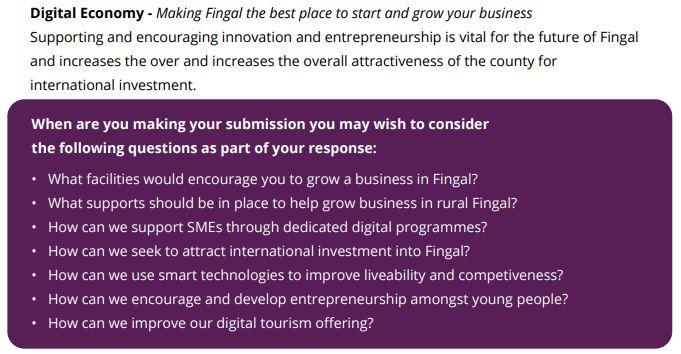
To further complement the consultation process, the Digital Fingal team organised design thinking workshops with strategic stakeholder groups. A total of seven stakeholder engagement workshops took place during the consultation period with the following groups
•
Fingal Senior Citizens Forum
•
Fingal Chamber of Commerce
•
Fingal Comhairle na nÓg
•
Fingal PPN Social Inclusion, Rural Development, Youth & Enterprise
•
Fingal PPN Climate Change, Environment & Water
•
Blanchardstown Centre for Independent Living
•
Fingal Councillor Workshop
At the workshops the Digital Fingal team gave an outline of the Digital Strategy framework and split the participants into groups to explore what areas they wanted the digital strategy to focus on. They were asked to imagine a blank canvas, with unlimited resources and unlimited budget – what would they like to see developed as part of the digital strategy for Fingal. At the end of the workshop all the suggestions were put on a board and they were then asked to prioritise their top three suggestions.
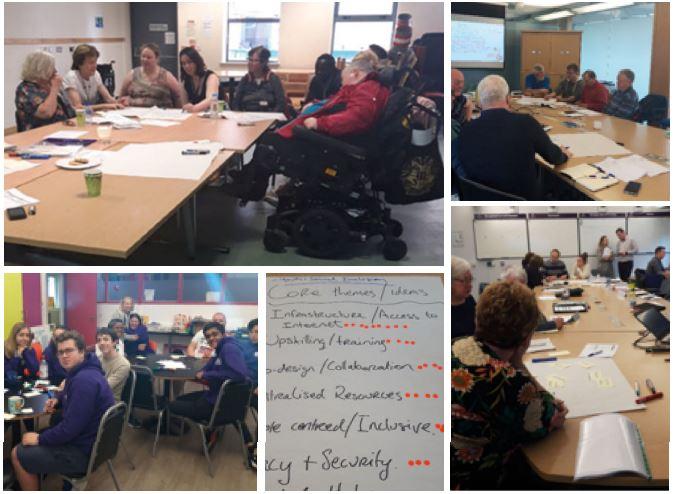
The contents from each workshop were recorded and added as submissions to the Digital Strategy Issues Paper consultation. Common themes emerged as a result of the stakeholder workshops which helped to structure a short online Digital Strategy Survey.
The purpose of the survey was to engage with a wider audience who might not be prepared to make a longer submission and to obtain input at public events.
The survey was promoted widely on social media. It was accessible through a weblink and on the Fingal Voices App. The Digital Fingal team set up stands at Fingal Libraries and at the Flavours of Fingal County Fair which had over 80,000 attendees. The consultation team ran a colouring competition at the Digital Fingal stand to engage a younger audience and gather a visual representation of what a Digital Fingal might look like in the year 2100.
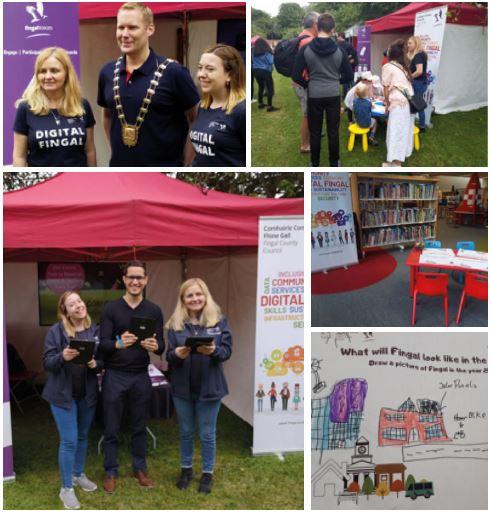
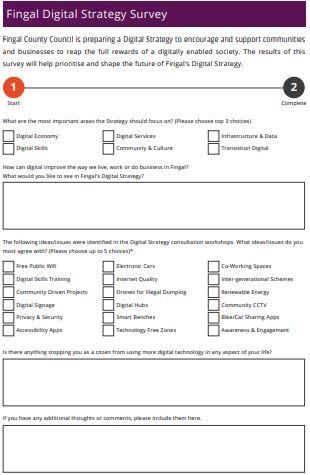
The Digital Strategy Public Issues Paper received a total of 26 submissions with 62 observations. These observations led to over 100 ideas that could potentially be developed to support Fingal’s Digital Strategy.
The Digital Fingal team examined each and every consultation submission and categorised suggestions and ideas into common themes. By doing this they were able to analyse the frequency of the most common suggestions. The graph below shows submission projects and ideas grouped together by common themes.
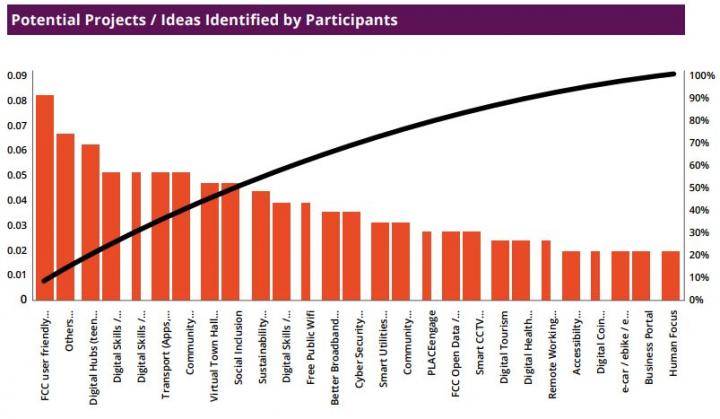
The most popular themes identified were:
•
Digital Government – E.g. Online Council services
•
Digital Business - E.g. Digital hubs & co-working facilities
•
Digital Infrastructure - E.g. Free WiFi & better broadband availability
•
Digital Community - E.g. Community engagement & Digital skills
337 participants took part in the Digital Strategy Survey. The survey focused on particular ideas and issues that had been raised in the Digital Strategy consultation workshops. Below are the key findings from the survey analysis.
Notably, 46% of survey participants said that they experienced barriers in accessing digital technology. The main reasons identified were poor connectivity, lack of skills and concerns over online safety.
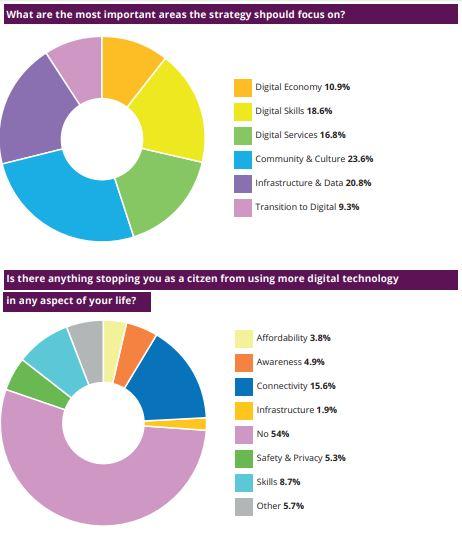
When asked to prioritise what ideas they would like the Strategy to focus on, participants ranked access to free public WiFi as the major priority.
